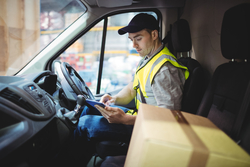 For fleet owners and operators, their vehicles are an asset, but potentially a liability too. Vans, trucks and other fleet vehicles are a common target for criminals, including those involved in organized crime and even terrorism.
For fleet owners and operators, their vehicles are an asset, but potentially a liability too. Vans, trucks and other fleet vehicles are a common target for criminals, including those involved in organized crime and even terrorism.
Vehicles can be taken for their own value or the value of their cargo. Or stolen to be used in criminal activities.
What are the threats against fleet vehicles, and what can you do to minimise your risk?
What is malicious use of fleet vehicles?
Many fleet vehicles are stolen each year. Around one in three is taken for cargo alone, and one third are stolen from owner premises. This kind of opportunist crime can harm businesses, especially through repeated incidents. In 2020, van theft cost businesses an average of £4,250.
Malicious vehicle theft is more complex than taking the opportunity to steal a vehicle or its contents. Terrorists may steal vehicles in order to fund their activities, or to weaponize vehicles, as happened in the Nice Bastille Day attack in 2016.
Vehicle theft is also a lucrative activity for organized crime gangs, along with other criminal activity such as theft and drug trafficking. Thieves take valuable commercial vehicles and either ship them immediately for resale or strip them down to component parts that can be sold on at a profit. Recent research has found that, on average, fleets lose around £16,000 a year due to vehicle or equipment theft.
What can fleet owners do to reduce risk?
The good news is that there are many measures that can help fleet managers reduce risk, often with minimal outlay. Ideally, companies would appoint a security manager, but if this is not feasible, a senior manager can be given a specific security detail as part of their role.
A security risk assessment will help to highlight any areas of weakness. Policies should be developed around areas such as security instructions, and the requirement of drivers to notify HQ in the event of any delays.
Careful planning can also help to reduce risk. This means planning routes, refuelling on site where possible, and avoiding unnecessary rest stops or breaks. Drivers can be trained in behaviours that will help to reduce the risk of attack, for example securing vehicles correctly and not picking up passengers en route.
What's your incident response plan?
Companies should always have a robust incident response plan in place so any incident can be met with a swift and well-considered response. These plans should be revisited regularly to ensure they remain fit for purpose and can be implemented easily should the need arise.
Recruitment procedures can also help to protect your security. Applicants should always provide at least two forms of photo ID and these should be checked carefully for tampering, errors or inconsistencies. Always take copies of identity documents. Government guidance provides further information.
How can standards help?
PAS 29000:2021 is just one of a set of standards that provide guidance on security measures to prevent criminals and terrorists from physically accessing commercial vehicles. This new PAS was developed by transport, safety and crime experts and is targeted at operators of light and heavy goods vehicles, as well as PSVs and mobile plant operators.
Nick Fleming, Head of Mobility and Transport Standards at BSI, said: “This new standard, developed with operators of commercial vehicles, encourages good practice in the managing of security risks that may help to reduce the threat of vehicles being used in acts that may cause intentional harm to the public or for organised crime.”
Transport Minister Robert Courts said of the PAS for managing physical vehicle security risks: “This is vital new guidance which will go a long way to help us in our fight against terrorism and organised crime. I wholeheartedly support this move and the British Standards Institution in their important work.”
You can download PAS 29000:2021 for free here. This standard also contributes to the UN Sustainable Development Goal 11 as it helps to reduce the risk of commercially operated vehicles being used in criminal or terrorist activities, keeping our cities safer and more resilient.
Connected future brings new threats
As vehicles become more connected to their surroundings, they will also be open to threats from cyber criminals and hackers.
BSI has published safety-critical guidance on managing cyber security risks to vehicles and infrastructure.
PAS 1885:2018 will help you understand better how to improve and maintain vehicle security and the security of associated intelligent transport systems (ITS).
PAS 11281 gives recommendations for managing security risks that might compromise safety in a connected automotive ecosystem.
Is your commercial fleet as protected as it could be?

 For fleet owners and operators, their vehicles are an asset, but potentially a liability too. Vans, trucks and other fleet vehicles are a common target for criminals, including those involved in organized crime and even terrorism.
For fleet owners and operators, their vehicles are an asset, but potentially a liability too. Vans, trucks and other fleet vehicles are a common target for criminals, including those involved in organized crime and even terrorism.